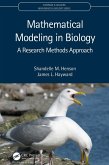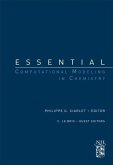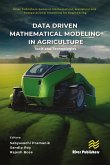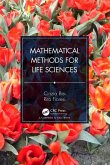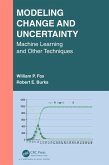Mathematical Modeling in Biology (eBook, ePUB)
A Research Methods Approach


Alle Infos zum eBook verschenken

Mathematical Modeling in Biology (eBook, ePUB)
A Research Methods Approach
- Format: ePub
- Merkliste
- Auf die Merkliste
- Bewerten Bewerten
- Teilen
- Produkt teilen
- Produkterinnerung
- Produkterinnerung

Hier können Sie sich einloggen

Bitte loggen Sie sich zunächst in Ihr Kundenkonto ein oder registrieren Sie sich bei bücher.de, um das eBook-Abo tolino select nutzen zu können.
Mathematical Modeling in Biology: A Research Methods Approach is a textbook written primarily for advanced mathematics and science undergraduate students and graduate-level biology students. Although the applications center on ecology, the expertise of the authors, the methodology can be imported to any other science, including social science and economics. The aim of the book, beyond being a useful aid to teaching and learning the core modeling skills needed for mathematical biology, is to encourage students to think deeply and clearly about the meaning of mathematics in science and to learn…mehr
- Geräte: eReader
- mit Kopierschutz
- eBook Hilfe
![Mathematical Modeling in Biology (eBook, PDF) Mathematical Modeling in Biology (eBook, PDF)]() Shandelle M. HensonMathematical Modeling in Biology (eBook, PDF)64,95 €
Shandelle M. HensonMathematical Modeling in Biology (eBook, PDF)64,95 €![Essential Computational Modeling in Chemistry (eBook, ePUB) Essential Computational Modeling in Chemistry (eBook, ePUB)]() Philippe G. CiarletEssential Computational Modeling in Chemistry (eBook, ePUB)44,95 €
Philippe G. CiarletEssential Computational Modeling in Chemistry (eBook, ePUB)44,95 €![Data Driven Mathematical Modeling in Agriculture (eBook, ePUB) Data Driven Mathematical Modeling in Agriculture (eBook, ePUB)]() Data Driven Mathematical Modeling in Agriculture (eBook, ePUB)113,95 €
Data Driven Mathematical Modeling in Agriculture (eBook, ePUB)113,95 €![Mathematical Methods for Life Sciences (eBook, ePUB) Mathematical Methods for Life Sciences (eBook, ePUB)]() Cinzia BisiMathematical Methods for Life Sciences (eBook, ePUB)53,95 €
Cinzia BisiMathematical Methods for Life Sciences (eBook, ePUB)53,95 €![An Introduction To Chaotic Dynamical Systems (eBook, ePUB) An Introduction To Chaotic Dynamical Systems (eBook, ePUB)]() Robert L. DevaneyAn Introduction To Chaotic Dynamical Systems (eBook, ePUB)56,95 €
Robert L. DevaneyAn Introduction To Chaotic Dynamical Systems (eBook, ePUB)56,95 €![Mathematical Modelling with Differential Equations (eBook, ePUB) Mathematical Modelling with Differential Equations (eBook, ePUB)]() Ronald E. MickensMathematical Modelling with Differential Equations (eBook, ePUB)45,95 €
Ronald E. MickensMathematical Modelling with Differential Equations (eBook, ePUB)45,95 €![Modeling Change and Uncertainty (eBook, ePUB) Modeling Change and Uncertainty (eBook, ePUB)]() William P. FoxModeling Change and Uncertainty (eBook, ePUB)56,95 €
William P. FoxModeling Change and Uncertainty (eBook, ePUB)56,95 €-
-
-
Features
- Minimal pre-requisites beyond a solid background in calculus, such as a calculus I course.
- Suitable for upper division mathematics and sciences students and graduate-level biology students.
- Provides sample MATLAB codes and instruction in Appendices along with datasets available on https://bit.ly/3fcLF3D
Dieser Download kann aus rechtlichen Gründen nur mit Rechnungsadresse in A, B, BG, CY, CZ, D, DK, EW, E, FIN, F, GR, HR, H, IRL, I, LT, L, LR, M, NL, PL, P, R, S, SLO, SK ausgeliefert werden.
- Produktdetails
- Verlag: Taylor & Francis eBooks
- Seitenzahl: 338
- Erscheinungstermin: 29. Dezember 2022
- Englisch
- ISBN-13: 9781000806106
- Artikelnr.: 66993729
- Verlag: Taylor & Francis eBooks
- Seitenzahl: 338
- Erscheinungstermin: 29. Dezember 2022
- Englisch
- ISBN-13: 9781000806106
- Artikelnr.: 66993729
- Herstellerkennzeichnung Die Herstellerinformationen sind derzeit nicht verfügbar.
James L. Hayward is Professor Emeritus of Biology at Andrews University, Michigan, USA. He earned a Ph.D. in zoology from Washington State University, and he has studied the behaviors and population dynamics of marine birds and mammals in the Pacific Northwest of North America since he began graduate studies in 1972. In addition, Jim has studied the behavior of marine iguanas and flightless cormorants on the remote and uninhabited island of Fernandina, the westernmost island in the Galapagos. He also is a recognized expert in the fossilization of eggshell in birds and dinosaurs.
Shandelle and Jim, a wife-husband research team, are widely published in both the technical and popular literature, and both have won awards for their teaching. They have applied mathematical methods to the behavioral dynamics of seabirds at Protection Island National Wildlife Refuge in the Strait of Juan de Fuca, Washington, USA since 2002. They reside in Niles, Michigan, USA and they have a daughter, son-in-law, and four grandsons. They enjoy hiking, geology, art, music, and literature.
Know About This Chapter. 1.2 The modeling cycle. 1.3. Biology. 1.4.
Mathematics. 1.5. Statistics. 1.6. Epistemology: How We Know. 1.7.
Exercises. 2. Avian Bone Growth: A Case Study. 2.1. What you should know
about this chapter. 2.2. Scientific Problem. 2.3. Translation into
Mathematics. 2.4. Model Parametrization. 2.5. Model Selection. 2.6. Model
Validation. 2.7. Exercises. II. Discrete-Time Models. 3. Discrete-Time
Maps. 3.1. What you should know about this chapter. 3.2. Compartmental
Model. 3.3. Linear Maps. 3.4. Nonlinear Maps. 3.5. Linearization. 3.6. The
Ricker Nonlinearity. 3.7. Exercises. 4. Chaos: Simple Rules Can Generate
Complex Results. 4.1. What you should know about this chapter. 4.2. Ricker
Model Revisited. 4.3. New Paradigms Associated from Chaos. 4.4. May's
Hypothesis. 4.5. Exercises. 5. Higher Dimensional Discrete-time Models.
5.1. What you should know about this chapter. 5.2. Intraspecific
Interactions. 5.3. Interspecific Interactions. 5.4. Example of an
Age-structured Single-Species Model. 5.5. Example of a Two-Species Model.
5.6. n-dimensional Linear Difference Equations. 5.7. Solving Linear Systems
of Difference Equations. 5.8. Nonlinear Systems. 5.9. Exercises. 6. Flour
Beetle Dynamics: A Case Study. 6.1. What you should know about this
chapter. 6.2. Flour Beetles. 6.3. Data. 6.4. Assumptions. 6.5. Alternative
Deterministic Models. 6.6. Stochastic Models. 6.7. Model Parametrization.
6.8. Model Selection. 6.9. Model Validation. 6.10. The "Hunt for Chaos"
Experiments. 6.11. Exercises. III. Continuous-time Models 7. Introduction
to Differential Equations. 7.1. What you should know about this chapter.
7.2. Compartmental Models. 7.3. Exercises. 8. Scalar Differential
Equations. 8.1. What you should know about this chapter. 8.2. Linear
Equations. 8.3. Nonlinear Equations. 8.4. Bifurcations. 8.5. Exercises. 9.
Systems of Differential Equations. 9.1. What you should know about this
chapter. 9.2. Linear Systems of ODEs and Phase Plane Analysis. 9.3.
Nonlinear Systems of ODEs. 9.4. Limit Cycles, Cycle Chains, and
Bifurcations. 9.5. Lotka-Volterra Models and Nullcline Analysis. 9.6.
Exercises. 10. Seabird Behavior: A Case Study. 10.1. What you should know
about this chapter. 10.2. The Scientific Problem. 10.3. Historical Data.
10.4. General Model. 10.5. Alternative Models. 10.6. Model Parametrization.
10.7. Model Selection. 10.8. Model Validation. 10.9. Test of a priori
predictions. 10.10. Steady-state model. 10.11. Discussion. Exercises. IV.
Regression Models. 11. Regression Models. 11.1. What You Should Know About
This Chapter. 11.2. Linear Regression. 11.3. Logistic Regression. 11.4.
Generalized Linear Models (GLMs). 11.5. Interaction Terms. 11.6. Exercises.
12. Climate Change and Seabird Cannibalism: A Case Study. 12.1. What You
Should Know About This Chapter. 12.2. The Scientific Problem. 12.3. Data.
12.4. Logistic Regression Analysis. 12.5. Model Validation. 12.6. Outcomes.
12.7. Climate Change, Cannibalism, and Reproductive Synchrony. 12.8.
Exercises. V. Appendix. A. Linear Algebra Basics. B. MATLAB: The Basics. C.
Connecting Models to Data: A Brief Summary with Sample Codes.
Know About This Chapter. 1.2 The modeling cycle. 1.3. Biology. 1.4.
Mathematics. 1.5. Statistics. 1.6. Epistemology: How We Know. 1.7.
Exercises. 2. Avian Bone Growth: A Case Study. 2.1. What you should know
about this chapter. 2.2. Scientific Problem. 2.3. Translation into
Mathematics. 2.4. Model Parametrization. 2.5. Model Selection. 2.6. Model
Validation. 2.7. Exercises. II. Discrete-Time Models. 3. Discrete-Time
Maps. 3.1. What you should know about this chapter. 3.2. Compartmental
Model. 3.3. Linear Maps. 3.4. Nonlinear Maps. 3.5. Linearization. 3.6. The
Ricker Nonlinearity. 3.7. Exercises. 4. Chaos: Simple Rules Can Generate
Complex Results. 4.1. What you should know about this chapter. 4.2. Ricker
Model Revisited. 4.3. New Paradigms Associated from Chaos. 4.4. May's
Hypothesis. 4.5. Exercises. 5. Higher Dimensional Discrete-time Models.
5.1. What you should know about this chapter. 5.2. Intraspecific
Interactions. 5.3. Interspecific Interactions. 5.4. Example of an
Age-structured Single-Species Model. 5.5. Example of a Two-Species Model.
5.6. n-dimensional Linear Difference Equations. 5.7. Solving Linear Systems
of Difference Equations. 5.8. Nonlinear Systems. 5.9. Exercises. 6. Flour
Beetle Dynamics: A Case Study. 6.1. What you should know about this
chapter. 6.2. Flour Beetles. 6.3. Data. 6.4. Assumptions. 6.5. Alternative
Deterministic Models. 6.6. Stochastic Models. 6.7. Model Parametrization.
6.8. Model Selection. 6.9. Model Validation. 6.10. The "Hunt for Chaos"
Experiments. 6.11. Exercises. III. Continuous-time Models 7. Introduction
to Differential Equations. 7.1. What you should know about this chapter.
7.2. Compartmental Models. 7.3. Exercises. 8. Scalar Differential
Equations. 8.1. What you should know about this chapter. 8.2. Linear
Equations. 8.3. Nonlinear Equations. 8.4. Bifurcations. 8.5. Exercises. 9.
Systems of Differential Equations. 9.1. What you should know about this
chapter. 9.2. Linear Systems of ODEs and Phase Plane Analysis. 9.3.
Nonlinear Systems of ODEs. 9.4. Limit Cycles, Cycle Chains, and
Bifurcations. 9.5. Lotka-Volterra Models and Nullcline Analysis. 9.6.
Exercises. 10. Seabird Behavior: A Case Study. 10.1. What you should know
about this chapter. 10.2. The Scientific Problem. 10.3. Historical Data.
10.4. General Model. 10.5. Alternative Models. 10.6. Model Parametrization.
10.7. Model Selection. 10.8. Model Validation. 10.9. Test of a priori
predictions. 10.10. Steady-state model. 10.11. Discussion. Exercises. IV.
Regression Models. 11. Regression Models. 11.1. What You Should Know About
This Chapter. 11.2. Linear Regression. 11.3. Logistic Regression. 11.4.
Generalized Linear Models (GLMs). 11.5. Interaction Terms. 11.6. Exercises.
12. Climate Change and Seabird Cannibalism: A Case Study. 12.1. What You
Should Know About This Chapter. 12.2. The Scientific Problem. 12.3. Data.
12.4. Logistic Regression Analysis. 12.5. Model Validation. 12.6. Outcomes.
12.7. Climate Change, Cannibalism, and Reproductive Synchrony. 12.8.
Exercises. V. Appendix. A. Linear Algebra Basics. B. MATLAB: The Basics. C.
Connecting Models to Data: A Brief Summary with Sample Codes.
- Technometrics

